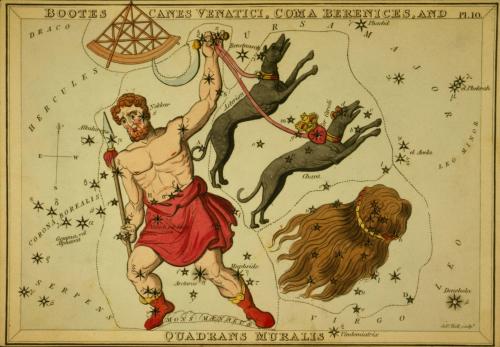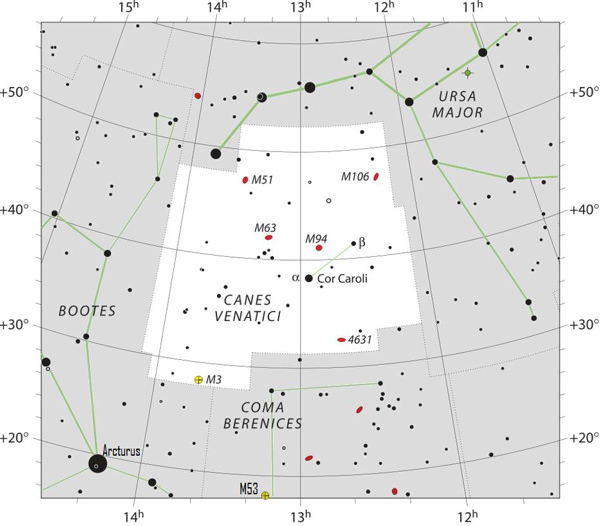
Tonight, or any March evening, look for the Big Dipper in the northeast sky. This star pattern – one of the most noticeable from Northern Hemisphere locations – is part of the constellation Ursa Major, the Greater Bear. And, if you can find the Big Dipper, you can also find two Hunting Dogs seen by the ancient stargazers to be nipping at the Bear’s heels. The Hunting Dogs are a separate constellation: tiny Canes Venatici.
You’ll need a dark sky to see these two little stars snuggled in the arc of the Big Dipper. Originally, they were called by the names Chara and Asterion.

The Huntings Dogs by Richard Bloxam. Image via Old Book Art Image Gallery.
But the eastern star is now called Cor Caroli, or Heart of Charles, named for the patron king of the Polish astronomer Johannes Hevelius, who devised this constellation in 1690.
The most famous object in this region of the sky is M51, the Whirlpool Galaxy. It is beautiful when seen through telescopes and appears dramatic in photographs.
Unfortunately, this galaxy is difficult or impossible to glimpse with binoculars.
The large galaxy at the bottom is the beautiful Whirlpool galaxy, aka M51 or NGC 5194. It’s a large spiral galaxy located in the direction of the constellation Canes Venatici. The smaller galaxy at top is a companion. Image via S. Beckwith (STScI) Hubble Heritage Team/STScI/AURA/ESA/NASA.
And there’s another faint object at the extreme edge of Canes Venatici that your binoculars should pick up. This object is M3, a globular star cluster located some 48,000 light-years away.
Messier 3 – aka M3 – from Adam Block/Mount Lemmon SkyCenter.
Binoculars see M3 as a dim blur of light, best seen with averted vision.
But, in a dark sky, M3 is relatively easy to find. Notice on the chart below that it lies almost midway between the bright star Arcturus and Cor Caroli:
Not sure how to find Arcturus? Remember to follow the arc of the Big Dipper’s handle in order to locate this star, as shown on the chart below:

You can always find the bright orange star Arcturus by following the arc in the handle of the Big Dipper.
Bottom line: How to use the Big Dipper to find the constellation Canes Venatici the Hunting Dogs!
EarthSky astronomy kits are perfect for beginners. Order today from the EarthSky store
Donate: Your support means the world to us
from EarthSky https://ift.tt/2GWT5FS

Tonight, or any March evening, look for the Big Dipper in the northeast sky. This star pattern – one of the most noticeable from Northern Hemisphere locations – is part of the constellation Ursa Major, the Greater Bear. And, if you can find the Big Dipper, you can also find two Hunting Dogs seen by the ancient stargazers to be nipping at the Bear’s heels. The Hunting Dogs are a separate constellation: tiny Canes Venatici.
You’ll need a dark sky to see these two little stars snuggled in the arc of the Big Dipper. Originally, they were called by the names Chara and Asterion.

The Huntings Dogs by Richard Bloxam. Image via Old Book Art Image Gallery.
But the eastern star is now called Cor Caroli, or Heart of Charles, named for the patron king of the Polish astronomer Johannes Hevelius, who devised this constellation in 1690.
The most famous object in this region of the sky is M51, the Whirlpool Galaxy. It is beautiful when seen through telescopes and appears dramatic in photographs.
Unfortunately, this galaxy is difficult or impossible to glimpse with binoculars.
The large galaxy at the bottom is the beautiful Whirlpool galaxy, aka M51 or NGC 5194. It’s a large spiral galaxy located in the direction of the constellation Canes Venatici. The smaller galaxy at top is a companion. Image via S. Beckwith (STScI) Hubble Heritage Team/STScI/AURA/ESA/NASA.
And there’s another faint object at the extreme edge of Canes Venatici that your binoculars should pick up. This object is M3, a globular star cluster located some 48,000 light-years away.
Messier 3 – aka M3 – from Adam Block/Mount Lemmon SkyCenter.
Binoculars see M3 as a dim blur of light, best seen with averted vision.
But, in a dark sky, M3 is relatively easy to find. Notice on the chart below that it lies almost midway between the bright star Arcturus and Cor Caroli:
Not sure how to find Arcturus? Remember to follow the arc of the Big Dipper’s handle in order to locate this star, as shown on the chart below:

You can always find the bright orange star Arcturus by following the arc in the handle of the Big Dipper.
Bottom line: How to use the Big Dipper to find the constellation Canes Venatici the Hunting Dogs!
EarthSky astronomy kits are perfect for beginners. Order today from the EarthSky store
Donate: Your support means the world to us
from EarthSky https://ift.tt/2GWT5FS


Aucun commentaire:
Enregistrer un commentaire